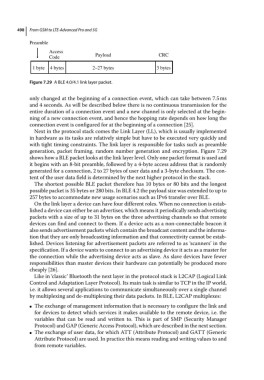Page 512 - From GMS to LTE
P. 512
498 From GSM to LTE-Advanced Pro and 5G
Preamble
Access
Code Payload CRC
1 byte 4 bytes 2–27 bytes 3 bytes
Figure 7.29 A BLE 4.0/4.1 link layer packet.
only changed at the beginning of a connection event, which can take between 7.5 ms
and 4 seconds. As will be described below there is no continuous transmission for the
entire duration of a connection event and a new channel is only selected at the begin-
ning of a new connection event, and hence the hopping rate depends on how long the
connection event is configured for at the beginning of a connection [25].
Next in the protocol stack comes the Link Layer (LL), which is usually implemented
in hardware as its tasks are relatively simple but have to be executed very quickly and
with tight timing constraints. The link layer is responsible for tasks such as preamble
generation, packet framing, random number generation and encryption. Figure 7.29
shows how a BLE packet looks at the link layer level. Only one packet format is used and
it begins with an 8‐bit preamble, followed by a 4‐byte access address that is randomly
generated for a connection, 2 to 27 bytes of user data and a 3‐byte checksum. The con-
tent of the user data field is determined by the next higher protocol in the stack.
The shortest possible BLE packet therefore has 10 bytes or 80 bits and the longest
possible packet is 35 bytes or 280 bits. In BLE 4.2 the payload size was extended to up to
257 bytes to accommodate new usage scenarios such as IPv6 transfer over BLE.
On the link layer a device can have four different roles. When no connection is estab-
lished a device can either be an advertiser, which means it periodically sends advertising
packets with a size of up to 31 bytes on the three advertising channels so that remote
devices can find and connect to them. If a device acts as a non‐connectable beacon it
also sends advertisement packets which contain the broadcast content and the informa-
tion that they are only broadcasting information and that connectivity cannot be estab-
lished. Devices listening for advertisement packets are referred to as ‘scanners’ in the
specification. If a device wants to connect to an advertising device it acts as a master for
the connection while the advertising device acts as slave. As slave devices have fewer
responsibilities than master devices their hardware can potentially be produced more
cheaply [26].
Like in ‘classic’ Bluetooth the next layer in the protocol stack is L2CAP (Logical Link
Control and Adaptation Layer Protocol). Its main task is similar to TCP in the IP world,
i.e. it allows several applications to communicate simultaneously over a single channel
by multiplexing and de‐multiplexing their data packets. In BLE, L2CAP multiplexes:
The exchange of management information that is necessary to configure the link and
●
for devices to detect which services it makes available to the remote device, i.e. the
variables that can be read and written to. This is part of SMP (Security Manager
Protocol) and GAP (Generic Access Protocol), which are described in the next section.
The exchange of user data, for which ATT (Attribute Protocol) and GATT (Generic
●
Attribute Protocol) are used. In practice this means reading and writing values to and
from remote variables.

